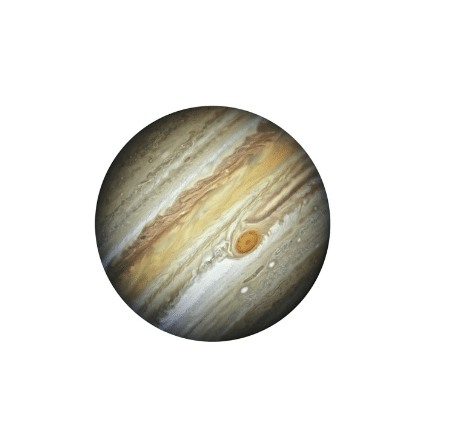Jupiter is the largest planet in the solar system and the first of the four gas giants. Its atmosphere consists of 86% hydrogen and 13% helium. It does not have a solid surface. It is constantly surrounded by cloud bands driven by violent winds, with its famous “Great Red Spot” (CNES). Its name comes from Jupiter, the most important god in Roman mythology.

| Caractéristiques | Jupiter | Terre |
| Diamètre | 140 000 km | 12 750 km |
| Rapport de masse | 318 | 1 |
| Rapport de gravité | 2,36 | 1 |
| Distance de soleil (UA) | 5,20 | 1 |
| Inclinaison / Axe de rotation | 3,1° | 23,5° |
| Période de rotation | 9 h 55 min | 1 j |
| Révolution autour du soleil | 12 ans | 365 j |
| Température max | +450°C | +58°C |
| Température min | -180°C | -89°C |
| Lunes | 67 connues | 1 |
The formation of the planet Jupiter, the largest in the solar system, is a fascinating process that dates back around 4.6 billion years. Here is an overview of the key stages of its formation:
- Primitive Solar Nebula
Jupiter formed from the primitive solar nebula, a vast cloud of gas and dust surrounding the young Sun. This cloud mainly contained hydrogen and helium, with traces of other elements.
- Core Accretion
Scientists believe that Jupiter began with the formation of a solid core, composed of rocks and ice. This core acted as a “seed” around which materials accumulated through gravitational accretion. Jupiter’s core could have a mass equivalent to about 10 to 20 times that of Earth.
- Gas Accretion
Once the core was sufficiently massive, it began to attract surrounding gases, mainly hydrogen and helium, which are the primary components of Jupiter today. This process led to the rapid growth of the planet, forming its thick gaseous atmosphere.
- Formation of a Satellite System
Alongside Jupiter’s growth, a disk of gas and dust continued to form around the planet. This disk gave rise to its many moons and rings. The Galilean moons—Io, Europa, Ganymede, and Callisto—are among the largest and most famous, formed from this disk.
- Stabilisation
After the massive accretion of gas, Jupiter eventually reached a stable state, where it ceased to grow significantly. The process of gravitational contraction released energy in the form of heat, which is still observable today as infrared radiation.
Jupiter is a gas giant, meaning it does not have a defined solid surface. Its atmosphere is primarily composed of molecular hydrogen and helium, with small amounts of methane, ammonia, water vapour, and other compounds.
For more information, you can consult the following websites:
